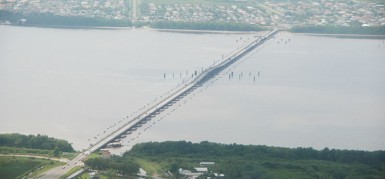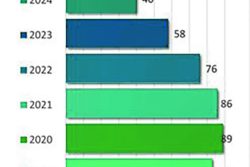The Demerara Harbour Bridge (DHB) can continue to operate indefinitely, according to engineer Joseph Holder, a former project manager for the bridge including during its construction.
In relation to the bridge’s design life, Holder, in a collection of papers on the bridge’s history, argues that there is no document signed by any engineer who took part in the design of the DHB that states its design life. It is not the practise of bridge designers to state a design life for their creations, he said, while adding that such a statement is meaningless. To illustrate, he asked what the design life of St George’s Cathedral is and said that there is usually no answer to this question when it is directed to persons who state that the DHB is past its design life.
“The DHB is comprised primarily of steel modules which may be replaced when circumstances require, as is the case with wooden boards on St George’s Cathedral. With replacements of components, the DHB can be given a prolonged and indefinite life like St George’s Cathedral,” the engineer said.

He acknowledged that it costs money to do so, and pointed out that the Demerara Harbour Bridge Corporation (DHBC) is doing so at present. “The revenue on its current account significantly exceeds its expenditure. At present, subventions are received from GOG to meet capital expenditure, but arrangements may be made for DHBC to finance most of this out of its surplus on current account, if the tolls are appropriately increased,” he said.
There have long been calls for a new bridge across the Demerara River and over the past years, the 37-year-old structure has been plagued by mechanical problems. It has been pointed out that the growth in traffic has taken a toll on the bridge, which opened in 1978 and has been the major artery linking Georgetown to the West Demerara. The floating steel structure, which measures 6074 feet (1851.4 metres), spans the Demerara River from the village of Peter’s Hall on the eastern side to Plantation Meer-Zorgen on the western end.
According to the pre-feasibility study for the new bridge, an average of 13,781 vehicles use the current bridge daily and the structure has passed its useful life and presents not only challenging operations and maintenance demand for the DHBC, but also impedes the progression of improved mobility between the east and west banks of Demerara.
The study had also noted that since 2008 the bridge has undergone capital repairs in excess of US$10 million which equates to an average annual maintenance cost of approximately US$2 million or US$ 1.1 million/ km. “This is considerable when one considers that the bridge’s average annual revenue for the past 10 years was about US$1.2 million,” it said.
“Considering the rigorous maintenance/repairs activities which had to be done over such a short period of time, it is plausible to conclude that the structure is beyond the end of its useful life and needs to be replaced,” the study had noted.
The views on the David Granger administration on a new bridge are not clear. However, in 2012, then APNU Member of Parlia-ment and current Minister of State Minister Joseph Harmon had told Stabroek News that a viable option in the form of a fixed high bridge is needed to link the regions 3 and 4. He had said that there was growth in economic activity along both banks of the river and added that that any plans for construction of a new structure would require broad consultation from residents on both sides of the river.
The former PPP/C government in the following year had invited expressions of interest (EOIs) from local and foreign parties to be a partner in the new Demerara Harbour Bridge and last year then Minister of Public Works Robeson Benn had said that 22 EOIs were received.
‘Functionally obsolete’
Holder’s papers, he said, were motivated by the repeated reference in public by various persons, including Members of Parliament, about the DHB being past its design life as well as an announcement by Benn that serious consideration was being given to the construction of a new bridge in the near future using a Build, Operate, Own and Transfer (BOOT) arrangement.
According to Holder, it may be said that traffic management problems may soon make the DHB functionally obsolete, in contrast to structurally obsolete, by its inability to accommodate the two streams of traffic which it controls, i.e. vehicles on the bridge and vessels on the river but the tolls have a bearing on this matter.
He pointed out that the revenue of DHBC is derived from collecting tolls from these two streams of traffic, and the sizes of the tolls have an important bearing on the magnitude of demand for passage by vehicles on the bridge and vessels through the bridge. The current high demand by vehicles is correlated by the low toll charged, he said.
“The volume of demand by vehicles for travel across the Demerara River is a function of the price charged by DHBC for the permission to do so. Variation of this price has a serious effect on the volume of demand, or as the economists would say the demand is characterized by a significant degree of elasticity,” the engineer wrote.
He pointed out that there is a high volume of demand in the mornings and afternoons of workdays, which raises serious problems of traffic management. “A survey should be done of the traffic flow during the peak periods to determine the numbers of vehicles, by category, and whether it was feasible to ration the use of bridge space by a price system which would vary with the time of day for certain vehicle types, instead of doing so by restricting travel in the peak period to one direction only as is done at present. Such a system would require payment of tolls at both ends of the bridge, instead of at one end as is done now,” he added.
According to Holder, under a BOOT arrangement for a new DHB, the magnitudes of the tolls for vehicular traffic on the new structure will be significantly greater than those currently charged on the DHB, due to the cost of its design, construction, operation and maintenance, and the need for the bridge investors to recover their capital in 20 years. “If the tolls on the DHB are raised now to the same extent as for the tolls for the proposed new bridge, there will be a large fall in demand by vehicular traffic,” he said.
The pre-feasibility study for the new bridge had said that “user tolls were considered to increase at a rate of 2% per year above the existing regime.”
The engineer said that unless there will be a significant subsidy to the users of the new bridge by the government, there will have to be a staged increase in the sizes of the tolls on the DHB over the next few years to avoid a price shock to bridge users, if the DHB is closed to traffic on the same day that the new bridge is opened. “This assumes that the DHB will be closed. If it is allowed to continue in business charging the current tolls, then it will compete with the new bridge to the detriment of the economic viability of the new bridge,” Holder said.
‘Redundancy’
Benn had said that once replaced, the DHB would be removed and possibly taken to cross the Puruni or Kurupukari rivers.
Holder noted that its continued existence at the current location after the new bridge is opened would provide redundancy in the provision of bridge capacity for transporting vehicles across the Demerara Harbour. If a ship collides with the new bridge and renders it incapable of transporting vehicles across the harbour, then severe transportation disruption would be minimised by the use of the floating bridge, while repairs are being done to the damaged bridge, the engineer said.
Meantime, he also noted that the current practise at the DHB is that its spans are retracted only once every 24 hours to permit ocean going vessels to pass. This is done when the tide is high. “In the years following its inauguration the DHB retracted its spans twice in 24 hours to permit such vessels to pass, but the practise was discontinued when the navigation aids on the DHB, which were necessary to facilitate such operation, deteriorated to an extent that made such operations impractical. The navigation aids have been rehabilitated, but night transits by vessels have not been restarted at the time of writing. The resumption of night transits would reduce the delay vessels experience from time to time in obtaining passage through the bridge, and may facilitate closing the bridge to vehicular traffic for shorter periods during daytime,” Holder asserted.
According to the pre-feasibility study for the new bridge, out of three locations examined, the Houston-Versailles location may be the most feasible for a new bridge. “This prefeasibility study has shown that a new high level four-lane fixed bridge structure at Houston-Versailles is the only economically feasible alternative, providing benefits to society that can amount to a minimum of some US$222 million over a 70-year life cycle at a capital cost of around US$264.5 million. The other alternatives proved to be uneconomical over the period. User tolls were considered to increase at a rate of 2% per year above the existing regime,” it said.








